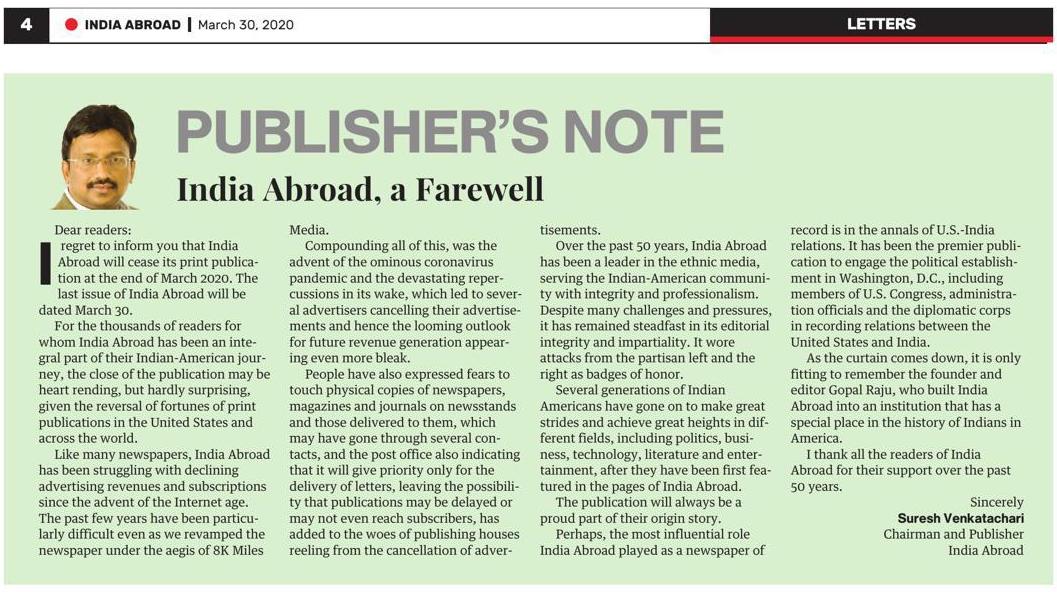On March 30, 2020, India Abroad published its last issue. The end
of this iconic publication in its fiftieth year has sent shockwaves through a
community media sector already reeling from COVID-19. As other leading community
media outlets face layoffs, reduced print runs, and even consider suspending
publication altogether, India Abroad’s legacy reveals not just the fragility but
also the resilience of the community media.

“India Abroad has been gasping for breath for some time, and the virus did it
in,” says Sunil Adam, the paper’s editor-in-chief. Launched in 1970 from the
mind – and pockets – of its founding publisher, Gopal Raju, India Abroad soon
became the flagship in a veritable fleet of news outlets by and for South Asian
communities in the U.S. In 2001, Raju sold the newspaper to the Indian online
portal, Rediff.com, which sold it again in 2016 to an Indian-American
entrepreneur named Suresh Venkatachari, who planned to make it the crown jewel
of a South Asian-American community news and entertainment empire. What its
later owners perhaps lost sight of, according to Adam, was that the paper was “a
community-owned entity, a newspaper catering to a niche community and a niche
audience, and with a role to play.”
India Abroad was the launching pad for Raju’s charitable and political forays
with the Indian American Foundation and the Indian American Center for Political
Action, highlighting the newspaper’s central role in giving its community a
voice to express its values – and its demands.
Says WNYC’s Arun Venugopal, whose journalism career began at India Abroad, “The
passing of India Abroad has raised real concern about who’s going to be our
voice – who will be able to hold those in power accountable.”

In its last years, India Abroad was just one of dozens of publications and
outlets serving South Asian communities, and many of these – Bangla
Patrika, Everest Times, Khasokhas,
Vishwa Sandesh, South Asian Insider,
Weekly Bornomola, Urdu News, Urdu
Times, and Punjabi Duniya to name a few – have told
us they have had to suspend publication amid the COVID-19 outbreak. Parikh
Worldwide Media, headquartered in New Jersey and with offices in New York City
and Chicago, is the country’s largest Indian-American publishing company, and
likewise decided in March to suspend printing its five periodicals: News
India Times, Desi Talk, Desi Talk in
Chicago, The Indian American, and Gujarat
Times. Indian Panorama ceased print publication last
November.
This roll call of South Asian-American publications underscores just how many
voices clamor to be heard from within the South Asian community. Adam describes
how, from his vantage point at India Abroad, he saw the Indian-American
community grow in size, regional and linguistic diversity, and amid tremendous
political polarization both at home and in the U.S. “It would be hard to reach
these different audiences without proper resources,” he says, but maintains that
“there is a tremendous need for a credible, well-done news vehicle.”
The diversity of perspectives and voices within the South Asian community media
landscape is what is lost in mainstream coverage of these communities. “There
are so many schisms that are not evident to the mainstream media, and it was so
exciting to navigate that as a journalist,” says Venugopal, observing that much
of the mainstream media’s difficulty in accurately covering race and immigration
is about lack of access to the complexity in communities of color: the inequity,
polarization, and diversity that exists within communities.
“Working at India Abroad, I got to see that we’re not a fossilized community,
we’re constantly changing,” he says. “There’s something particularly thrilling
about being able to voice and articulate that, and in this intimate voice that
you can only hear in this corner of the media world. If we lose this good
journalism, we’re losing something of our collective narrative – our
community’s ongoing story.”

Other communities are losing their essential voices amid this pandemic too.
Gazeta
Brazilian News, the largest Portuguese-language newspaper
serving Brazilian communities in Florida, Boston, New York and New Jersey, has
suspended its print edition after 25 years, as have Illyria, a
27-year-old Albanian-American newspaper based in New York City, and the
32-year-old Norwood News, a community newspaper covering the
Bronx. World Journal, headquartered in New York City and with
offices throughout the East Coast, Midwest, and West Coast, is the leading
newspaper published in Chinese communities across the U.S., and has had to
drastically reduce its page count; before the pandemic its issues ran upwards of
140 pages. The Indypendent, a Brooklyn-based progressive
newspaper, has had to cut its circulation by nearly 50%, and Daily Challenge,
which serves New York City’s Black community, has had to decrease its normally
five-times-a-week publication schedule.
These losses are happening even as the demand for community-based journalism
continues to rise. Publishers are innovating and thinking creatively to continue
meeting this demand. Rick Ho, the general manager of Sing Tao
Daily, which serves the Chinese-American community in New York City,
told us that his team began preparing for quarantine as early as December,
linking laptops to the outlet’s server in preparation for the advertising and
circulation departments to work remotely. Hank Levy, publisher and
editor-in-chief of the Jewish Post began offering deeply
discounted special ads to local businesses, and for politicians to communicate
with constituents. Khalil ur-Rehman, editor of the Urdu Times,
organized a back office in Pakistan to design a PDF version of his publication
for his readers to download and print.
Creativity, innovation, and resilience are hallmarks of this sector after all.
After his long and illustrious career at India Abroad, Sunil Adam is still not
done. “I want to retire not as the guy who ended a 50-year paper, but as the guy
who started something new, with a future.” He’s launching a platform for
commentary and personal essays by Indian Americans. “I want the Indian-American
perspective to come out.”
|
|
Introducing CCM’s Partner in Chicago
In January, we kicked off our first strategic national partnership with the new
Chicago
Independent Media Alliance (CIMA). Already, CIMA has brought together 60
independent media outlets into a network of mutual support and collaboration. It
has conducted the first-ever survey to map out Chicago’s community media
landscape, organized joint ad-buys on behalf of member outlets, and secured
grant funding for an editorial project with 26 of its member outlets.
At the end of this month, 40 of CIMA’s member outlets are launching a
coordinated fundraising campaign to support Chicago community media amid
COVID-19, which will be hosted on a joint fundraising portal CIMA is
developing. CIMA is currently raising funds to match funds raised during the
30-day online campaign. To learn more about how to support Chicago community
media, please contact Tracy Baim, publisher of The Chicago Reader: [email protected]
|
|
Upcoming at CCM
We’re staying in close touch with community media outlets as they continue to
report from the front lines of the COVID-19 pandemic during a worsening economic
crisis. We’re rolling out programming to help them access funds and get great
ideas from experts – and each other.
Last week:
-
We hosted a webinar with step-by-step guidance on applying for relief funding
through the SBA Loan Program for Small Businesses. A
recording is available here.
-
Our Advertising Boost Initiative, which helps New York
City-based outlets access a greater share of city agencies’ advertising
budgets, held a two-day remote training on developing a professional
media kit and reaching out to advertisers. If you are the
publisher of a New York-based community news organization and would like to
participate in this initiative, please contact Darlie
Gervais.
Next week, we’ll launch our conversation series with publishers
from around the country who will share best practices and ideas for
maintaining revenue streams during the COVID-19 crisis. On April 21, we’ll be in
conversation with John Wotowicz, publisher of THE
CITY. Register to attend here.
|
|
Congratulations to the Community Media Awardees!
Please join us in congratulating the many of CCM’s constituent community media
outlets named this week as recipients in the first round of The
Facebook Journalism Project’s $5,000 FPJ Community Network grants. A full
list of awardees can be found here.
|
|
Resources
COVID-19 Emergency Grants and Relief Funds
For Organizations:
-
Google News' Journalism Emergency Relief Fund will support
small- and medium-sized media outlets producing original news content
for local communities. Funding will range from the low thousands for small
outlets to the low tens of thousands for larger ones. Details here.
-
Institute for Nonprofit News is partnering with the Facebook Journalism
Project to launch a $25 million COVID-19 Local News Relief
Fund, to provide grants to local news organizations across the
U.S., ranging from $25,000-$100,000. Learn more here.
-
LION Publishers is offering mini-grants to its members for
consultant assistance in applying for the federal paycheck protection
program. Apply here.
-
Society of Environmental Journalism’s Fund for Environmental
Journalism now accepting proposals for story grants on
climate, conservation and environmental health in North America. Rapid
Response Grants (including stipend) are available up to $2,500 per
individual or $5,000 for team or news outlet projects. Read more here.
For Individuals:
-
CUNY Newmark J-School is launching Newmark
J-Corps, a professional news service to report on the COVID-19
pandemic in New York City and in communities across the country. Up to 70
current Newmark J-School students will be deployed to report with the
J-Corps, and each student will receive a living stipend of $4,000, increased
this year from $1,000. Learn more here.
-
Economic Hardship Reporting Project announced on Twitter
that it has created an emergency fund dedicated to covering COVID-19 and
financial hardship. To apply, contact [email protected].
-
The Fund for Investigative Journalism has launched a new
emergency grant program for U.S.-based freelance investigative journalists
working on stories on COVID-19 that break new ground and expose wrongdoing
in the public or private sector. Grants of up to $10,000 will be made on a
rolling basis. Learn more and apply here.
-
A group of journalists have created the Journalist Furlough
Fund on behalf of fellow journalists who have been furloughed, or
had their hours or income reduced in response to COVID-19. You can give here,
or apply for financial assistance here.
-
A group of individual journalists have created a Microloans for
Journalists program, offering interest-free $500 loans for
professional journalists who have been laid off, furloughed, or had their
pay cut in response to COVID-19. More information here.
Ongoing
Emergency Assistance Programs
-
Authors League Fund offers emergency grants for authors,
dramatists, journalists, and poets. Apply here.
-
Carnegie Fund for Authors offers emergency grants for
American authors who have published at least one full-length work. Learn
more here.
-
The Committee to Protect Journalists’ Gene Roberts Fund for
Emergency Assistance provides financial support to journalists at
risk. Only journalists approved to receive assistance from CPJ's Journalist
Assistance program will be awarded emergency grants. Details here.
-
International Women’s Media Foundation’s Journalism Relief
Fund is open to women-identifying journalists
who urgently need assistance, and will provide small grants of up
to $2,000. Special consideration will be given on a case-by-case basis to
those who have greater financial need. Details here.
-
PEN America is expanding its longstanding Writers’
Emergency Fund, and will distribute grants of $500 to $1,000 based on
applications that demonstrate an inability to meet an acute financial need,
especially one resulting from the impact of the COVID-19
outbreak. Information here.
Local Opportunities
-
Philadelphia: The Lenfest Institute for Journalism is
committing $70,000 in support to Asian American Journalists Association
Philadelphia Chapter (AAJA Philly), the National Association of Hispanic
Journalists Philadelphia Chapter (NAHJ Philly), and the Philadelphia
Association of Black Journalists (PABJ). Learn more here.
-
New Mexico: The New Mexico Local News Fund is making
available emergency grants (capped at $750) for journalists impacted by
COVID-19. Learn more here.
-
New York City: The New York City Community Trust has
launched an emergency fund for local nonprofits providing critical services
on the ground. Learn more about donating or receiving funds here.
-
Virginia: The Tidewater Media Guild, Timesland Media Guild
and Blue Ridge NewsGuild have launched the Virginia is for Journalists
Relief Fund. For more information, go to the fund’s GoFundMe page.
|
|
Trainings and Tools
American Press Institute has compiled a list
of free tools, content, and funding opportunities for local
newsrooms.
Fiscal Management Associates has created a Paycheck
Protection Program Toolbox for nonprofits, including a Mutual Aid Fund,
templates and calculators, and upcoming free clinics for nonprofit managers on
applying for federal SBA loans.
Freedom Forum Institute has compiled a resource
page with webinars, surveys, funding opportunities, and COVID-19 resource
guides.
LION Publishers has launched the LION
Expert Network to connect local outlets with expert news-management
consulting services.
Local Media Association has created a resource
page with coverage and funding opportunities for local media outlets,
including a webinar
on how to set up a Local News Fund.
Poynter has compiled a resource page of upcoming remote
training opportunities.
Umbrex has developed a pandemic
playbook, offering pro-bono coaching and consulting for small businesses
and nonprofits.
Freelancers can also find guidance
on benefits and relief for freelancers under the CARES Act, and can connect
with other freelancers for resources and advice in this Support
for Freelance Journalists Slack Workspace.
|
|
Food for Thought
As COVID-19 continues to devastate
the U.S. news media, and unemployment assistance
for freelancers in California stalls, we’d like to direct your attention to
a recent report by the Native American Journalists Association, analyzing
mainstream media
coverage of Native American communities.
|
|
Share with Us
We’d love to know what’s making you think about community media in new ways too,
so we encourage you to share any reports, databases, opportunities, or
visualization projects you want us to know about. Please send them to our
newsletter editor, Kavitha Rajagopalan: [email protected].
|
|
Sign up for our newsletter.
|
|
|
|
|